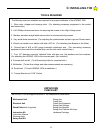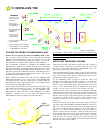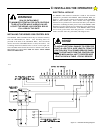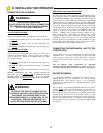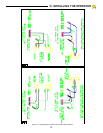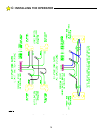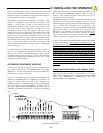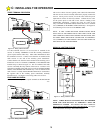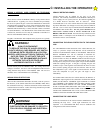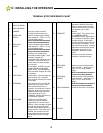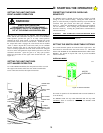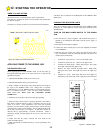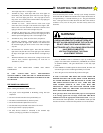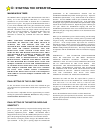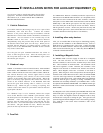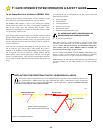
17
WIRING A KEYPAD, CARD READER OR TELEPHONE
ENTRY SYSTEM
These devices activate the HDSWG 1000 by a relay contact closure
within the device. Typically, two wires or terminals are provided by
the device to operate the gate. Follow the manufacturers instructions
on locating these connections. If one of the connections at the device
is labelled as COMMON, then connect this to Terminal #13 of the
HDSWG 1000 Terminal strip. Connect the other contact to Terminal
#11 (PULSE INPUT). If no identification of the connections is noted
at the device, then the two wires may be connected to terminals #11
and #13 of the HDSWG 1000 in any order.
Keypads, Card Readers and Telephone Entry Systems are typically
located remotely from the HDSWG 1000. The wiring used is low
voltage or CLASS 2. Be sure to run an independent conduit for this
wiring from the Entry Device to the HDSWG 1000. The wire size
should be #16 or #18 stranded for ease of handling.
WIRING VEHICLE DETECTORS
There are three connections that need to be made; 1) the AC power to
the Detector, 2) the control connection to the HDSWG 1000, and 3)
the connection to the loop. All these connections will be made at the
Vehicle Detector connector. Follow the wiring instructions provided
by the Vehicle Detector Manufacturer.
VEHICLE DETECTOR POWER
Vehicle Detectors may be ordered for 115 VAC or 24 VAC
operation. The Auxiliary Transformer in the HDSWG 1000 may be
used to supply 24 VAC power, however, the cautions regarding use
of a Radio Receiver described must be observed. Allstar
recommends that a 115 VAC Vehicle Detector be used to precluded
any future difficulties even though a receiver may not be installed at
this time. The 115 VAC may be obtained from the HDSWG 1000 at
the HDSWG 1000 Control Box. The AC power should never be
taken from a location where it will be switched off at the
HDSWG 1000 Power Switch. Be aware that any connection to the
HDSWG 1000 4 x 4 handy box will invalidate the UL Listing since
the Detector will be "cord connected".
CONNECTING THE VEHICLE DETECTOR TO THE HDSWG
1000
For a REVERSING LOOP connection of the Vehicle Detector, the
"relay" or "presence" output of the Detector will be connected to
Terminal #9 (REVERSING LOOP) of the HDSWG 1000 and the
RELAY COMMON wire will be connected to Terminal #13
(COMMON) of the HDSWG 1000. As long as a relay closure is
present on these two lines, the HDSWG 1000 will not allow the gate
to close. If the Vehicle Detector is activated and the gate is in the
closed position, the presence of this signal will prevent the HDSWG
1000 from opening the gate. If the gate is opening, the gate will
continue to open. If the signal is removed before the Timer to Close
times out after opening, the gate will close after the Timer to Close
has completed its cycle. If the signal is removed after the Timer to
Close has completed its cycle, the gate will begin to close
immediately.
For a FREE EXIT connection of a Vehicle Detector, the RELAY or
PRESENCE output signal will be connected to Terminal #10 (HOLD
OPEN) and the RELAY COMMON signal connected to Terminal
#13 (COMMON) of the HDSWG 1000. DO NOT CONNECT THE
FREE EXIT OUTPUT SIGNAL TO ANY OTHER TERMINAL,
SUCH AS PULSE OPEN, BECAUSE THE GATE WILL
CLOSE
AFTER REACHING THE OPEN LIMIT AND THE TIMER TO
CLOSE HAS COMPLETED ITS CYCLE, EVEN THOUGH THE
VEHICLE HAS NOT EXITED THE FREE OUT LOOP.
CONNECTING THE LOOP WIRES
Follow the instructions of the Vehicle Detector Manufacturer when
connecting the loop wires. Good, tight connections are most
important. It is recommended that these wires be soldered to the
wiring harness of the Vehicle Detector.
WARNING!
RISK OF ENTRAPMENT!
TO REDUCE THE RISK OF INJURY OR DEATH:
LOCATE KEYPAD, CARD READER, KEY SWITCH
OR SIMILAR ENTRY DEVICES IN A LOCATION
WHERE A USER CAN NOT REACH THROUGH THE
GATE OR FENCE TO ACTIVATE THE GATE
OPERATOR. THE RECOMMENDED DISTANCE
BETWEEN THE GATE OR FENCE AND
ACCESSORY SWITCH IS 10 FEET.
WARNING!
IMPROPER WIRING COULD CAUSE
ELECTROCUTION OR DAMAGE TO CIRCUITRY.
FOLLOW LOCAL BUILDING AND ELECTRICAL
CODES.
C:
INSTALLING THE OPERATOR



